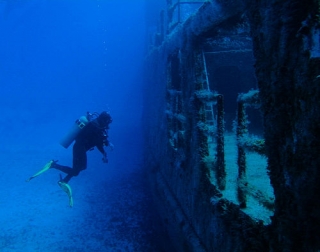In the depths of the Red Sea lies the Dunraven, remarkably encrusted with marine life. Wreck diving can be a marvellous experience, but exploring a vessel this ancient is even more fascinating. Let's examine the history surrounding this legendary wreck.
Beyond Reality
Exploring its exterior is straightforward and safe; venturing inside is reserved for experienced divers. Due to its inverted position, the interior has complete darkness and no easy exits.

It wasn't until 1978 when porcelain pieces recovered by Israeli divers provided definitive clues about this mysterious wreck's true origins.
Her Origins
Built at Mitchell & Company's Newcastle shipyard, she was a fashionable "steamer" - able to sail under both steam and canvas. Enormous for her time at 80m length and 10m beam, she could carry 1,613 tonnes. Purchased by London's W. Milburn shipping line, she served exclusively on the Bombay route.
On her final voyage, she carried timber and steel for Britain's nascent Indian metal industry, returning to Liverpool with cotton, wool and textiles. The outbound journey proved uneventful, and on 6 April 1876 she departed Bombay homeward with 25 crew.
A Chain of Errors
At 1am on 25 April, the first mate sighted land, assuming it was Shadwan Island. Fifteen minutes later he spotted a light, mistaken for Ashrafi Lighthouse. The boatswain on watch didn't question this, despite the helmsman never seeing the light and the actual lighthouse being miles away in the Gobal Strait.
When the captain came on deck at 3:40am, they were heading straight for land - now visible just six or seven miles to starboard. He altered course further starboard, bringing them closer still. Ten minutes later, the lookout reported an object in the water - possibly a buoy. Receiving no response, when the mate and boatswain saw it, they assumed a ship and ordered engines stopped.
Too late. The "object" (actually Beacon Rock reef) was upon them, collision inevitable.
The bilge pumps worked furiously, but the wound proved mortal. By 7am water reached the engines; by noon the starboard deck was submerged and the crew abandoned ship. Four hours later an Arab dhow rescued them, delivering the men to Sinai.
Subsequent investigations found both captain and boatswain guilty for "making no effort to verify the Dunraven's position from noon 24 April until collision at 3:50am 25 April, constituting fatal negligence."
Diving the Wreck
The Dunraven's exterior dive suits any qualified diver, but penetrating her requires experience in this type of diving, especially considering she lies upside-down, keel toward the surface.

Her remains rest on sandy bottom with scattered rocks, all encrusted with coral. The deepest section is the stern at 28m. The bow sits at 22m against the reef base. The 80m hull remains remarkably intact, resting at 17m depth upside-down, completely colonised by hard and soft corals. The propeller and rudder are standout features. The soft coral garden here creates a spectacular colour display. Swimming along the hull (where visibility often exceeds 20m), you'll see both masts with crow's nests and rigging, plus the funnel lying nearby.

Interior exploration demands advanced wreck diving qualifications. Entry is amidships where the hull is fractured near the engine room. Carry dual torches - inside you'll find the massive coal boiler. Maintain perfect buoyancy and finning technique to avoid disturbing silt.
Moving aft, you'll spot remnants of wooden staircases. The holds still contain cargo remnants like cotton bales and wool. Few artefacts remain - most were salvaged by Israeli divers who first explored the wreck in 1977.
Marine life includes abundant reef fish, humphead wrasse (Cheilinus undulatus), groupers, and sometimes pelagic species like tuna and trevally hunting glassfish (Parapriacanthus guentheri) that shelter in the wreck.

Don't neglect the surrounding seabed - particularly the seaward side where whitetip reef sharks (Triaenodon obesus) often rest, especially at dawn.











